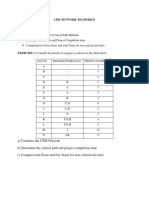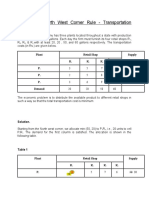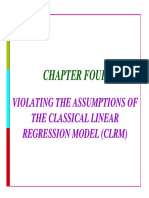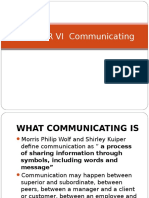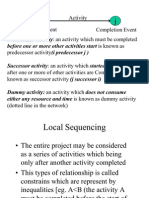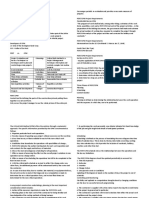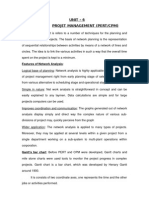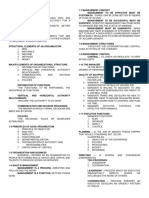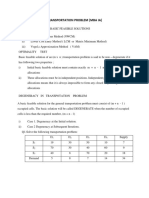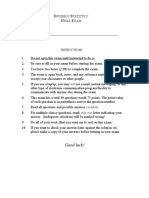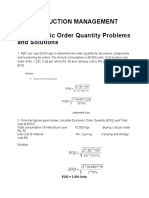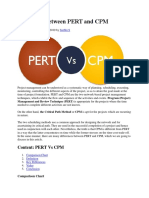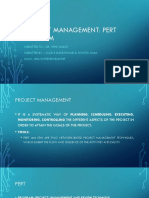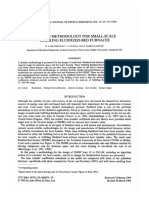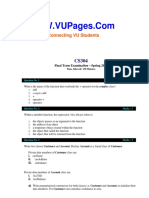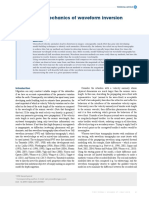CPM AND PERT Dr.
Satyanand Singh
�PERT AND CPM
➢Project management can be understood as a systematic way of planning, scheduling,
executing, monitoring, controlling the different aspects of the project, so as to attain
the goal made at the time of project formulation.
➢PERT and CPM are the two network-based project management techniques, which
exhibit the flow and sequence of the activities and events.
➢PERT is appropriate for the projects where the time needed to complete different
activities are not known.
➢On the other hand, the Critical Path Method or CPM is apt for the projects which are
recurring in nature.
�DIFFERENCES BETWEEN PERT AND CPM
1. PERT is a project management technique, whereby planning, scheduling,
organising, coordinating and controlling uncertain activities are done. CPM is a
statistical technique of project management in which planning, scheduling,
organising, coordination and control of well-defined activities take place.
2. PERT is a technique of planning and control of time. Unlike CPM, which is a
method to control costs and time.
3. While PERT is evolved as a research and development project, CPM evolved as a
construction project.
4. PERT is set according to events while CPM is aligned towards activities.
�5. A deterministic model is used in CPM. Conversely, PERT uses a probabilistic model.
6. There are three times estimates in PERT, i.e. optimistic time , most likely time,
pessimistic time . On the other hand, there is only one estimate in CPM.
7. PERT technique is best suited for a high precision time estimate, whereas CPM is
appropriate for a reasonable time estimate.
8. PERT deals with unpredictable activities, but CPM deals with predictable activities.
9. PERT is used where the nature of the job is non-repetitive. In contrast to, CPM
involves the job of repetitive nature.
�CPM TIME ANALYSIS
Representation
𝑇𝑖𝑗 = Estimate completion time of activity 𝑖, 𝑗
𝐸𝑆𝑖𝑗 = Earliest starting time of activity 𝑖, 𝑗
𝐸𝐹𝑖𝑗 = Earliest finishing time of activity 𝑖, 𝑗
𝐿𝑆𝑖𝑗 = Latest starting time of activity 𝑖, 𝑗
𝐿𝐹𝑖𝑗 = Latest finishing time of activity 𝑖, 𝑗
�EXAMPLE PROBLEM
1 4
3
�FORWARD PASS COMPUTATION
➢Zero be the starting time for the project
➢ 𝐸𝐹 𝑖𝑗 = 𝐸𝑆 𝑖𝑗 + 𝑡𝑖𝑗
➢𝐸𝑗 = 𝑀𝑎𝑥 𝐸𝑗 + 𝑡𝑖𝑗
� Latest Time
Earliest Time
2
0
1 4 5
1
�BACKWARD PASS COMPUTATION
➢For ending event assume E=L
➢Formula for backward computation= 𝐿𝐹 𝑖𝑗 − 𝑡𝑖𝑗
➢= 𝐿𝑗 − 𝑡𝑖𝑗 =min 𝐿𝑗 − 𝑡𝑖𝑗
� Latest Time
Earliest
Time
4
4
0 2
0
5
1 4 5
4
1
�DETERMINATION OF FLOATS AND SLACK TIMES
➢Float : it is defined as the difference between the latest and earliest activity time
➢Slack : slack is defined as the difference between the latest and earliest event time
�FLOATS
➢TOTAL FLOAT (TF)
➢ 𝑇𝐹 𝑖𝑗 = 𝐿𝑆 𝑖𝑗 − 𝐸𝑆 𝑖𝑗
➢Or 𝑇𝐹 𝑖𝑗 = 𝐿𝑗 − 𝐸𝑖 − 𝑡𝑖𝑗
➢Where
▪ 𝐸𝑖 =Earliest time for tail event
▪ 𝐿𝑗 = Latest time for head event
▪ 𝑡𝑖𝑗 =Normal time for activity 𝑖, 𝑗
FREE FLOAT (FF)
➢𝐸𝑗 − 𝐸𝑖 − 𝑡𝑖𝑗
INDEPENDENT FLOAT (IF)
➢𝐸𝑗 − 𝐿𝑖 − 𝑡𝑖𝑗
�Activity Normal time Earliest Time Latest
Start (ES) Finishing Start Finish
𝑡𝑖𝑗
ES= 𝐸𝑖 EF=𝐸𝑖 + 𝑡𝑖𝑗 LS=𝐿𝑗 − 𝑡𝑖𝑗 LF= 𝐿𝑗
1-2 4 0 4 0 4
1-3 1 0 1 3 4
2-4 1 4 5 4 5
3-4 1 1 2 4 5
1 3 4 2
�TOTAL FLOAT
Total Float (TF) Free Float (FF) Independent 𝐸𝑗 𝐿𝑖
Float (IF)
LS-ES 𝐸𝑗 − 𝐸𝑖 − 𝑡𝑖𝑗 𝐸𝑗 − 𝐿𝑖 − 𝑡𝑖𝑗
0 0 0 4 0
3 0 0 1 0
0 0 0 5 4
3 3 0 5 4
5 7 9 6 8
�Critical Activity- An activity is said to be critical if the total float 𝑇𝐹𝑖𝑗 for any
activity 𝑖, 𝑗 is zero.
Total Float (TF) Free Float (FF) Independent Float 𝐸𝑗 𝐿𝑖
(IF)
LS-ES 𝐸𝑗 − 𝐸𝑖 − 𝑡𝑖𝑗 𝐸𝑗 − 𝐿𝑖 − 𝑡𝑖𝑗
0 0 0 4 0
3 0 0 1 0
0 0 0 5 4
3 3 0 5 4
� Latest Time
Earliest Critical Path 1-2-4
Time Cost = 4+1=5 Days
4
4
0 2
0
5
1 4 5
4
1
�CRITICAL PATH CONDITIONS
i. 𝐸𝑆𝑖 = 𝐿𝐹𝑖
ii. 𝐸𝑆𝑖 − 𝐿𝐹𝑗
iii. 𝐸𝑆𝑗 − 𝐸𝑆𝑖 = 𝐿𝐹𝑗 − 𝐿𝐹𝑖 = 𝑡𝑖𝑗


